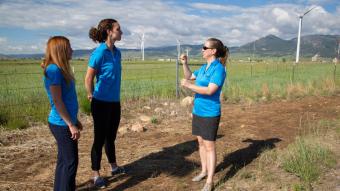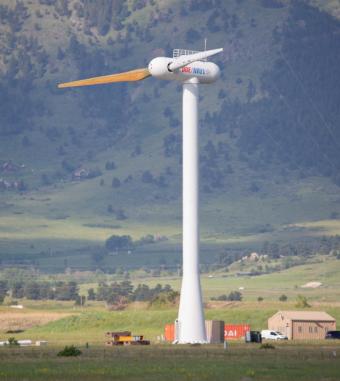Palm tree-inspired wind turbine being tested in Colorado

The scaled-down prototype soon to begin operational testing at the National Wind Technology Center in Boulder, though, takes its inspiration from a decidedly un-Colorado source. The Segmented Ultralight Morphing Rotor, or SUMR, is more palm tree than pine.
“Palm trees bend in the wind but don’t break,” said Kathryn Johnson, associate professor of electrical engineering at Mines. “The idea that Eric Loth at the University of Virginia came up with is to use that same bio-inspired load alignment for wind turbine blades.”

The end result could be the largest wind turbine ever built, a behemoth capable of producing 50 megawatts of power from an offshore wind farm. The largest turbines in production today are rated for just 5-10 megawatts.
The key is flexibility, Johnson said. The turbine’s two ultralight, ultralong blades are affixed in a downwind position, instead of the traditional upwind configuration. That will allow the blades to bend out of strong wind, therefore putting less stress on the other turbine components.
“Part of the goal for every new wind turbine design is to reduce what’s called the levelized cost of energy,” Johnson said. “That super flexibility means you don’t need as much material or as expensive a material. You could always make something super stiff by adding a ton of carbon, but that’s so expensive.”
Making sure the ultralight, ultraflexible turbine behaves as desired is where Johnson and her PhD students Dana Martin and Sepideh Kianbakht come in. A control systems expert, Johnson is working with colleagues at the University of Colorado on the control system that oversees the turbine’s blade pitch, generator torque and more.
“When things get more flexible, they get harder to control,” Johnson said. “The big thing because of the flexibility is the deflection of the blade tips—how much it’s moving out of the normal position, upwind and downwind. If you picture something really flexible that you start shaking, it will go both ways. It will swing back upwind even when the wind is pushing it downwind as it vibrates. We’re making sure it doesn’t come too far upwind and hit the tower—because that would destroy everything.”
Once full operational testing begins, researchers plan to collect data on blade strain, tip deflection, power, torsion and more for up to a year. That information will then guide the next stage of the project, scaling up the prototype to a 50-megawatt giant.
So, if you drive by the National Renewable Energy Laboratory’s National Wind Technology Center off Highways 93 and 128 and find yourself slightly concerned by one of the turbine’s blades flapping in the wind, that’s entirely the point.
###
This research is funded by the U.S. Department of Energy’s Advanced Research Projects Agency–Energy (ARPA-E) program. Also collaborating on the UVA-led project are researchers from the University of Illinois, University of Colorado, National Renewable Energy Laboratory and the University of Texas Dallas. The SUMR team will showcase their project at ARPA-E Energy Innovation Summit in Denver on July 8-10.




